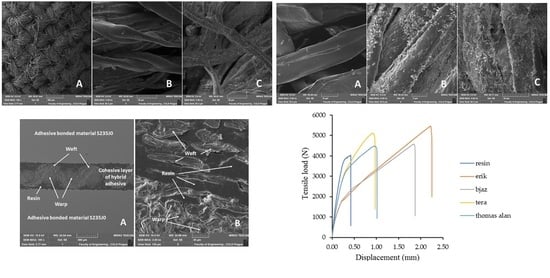Quasi-Static Shear Test of Hybrid Adhesive Bonds Based on Treated Cotton-Epoxy Resin Layer
Abstract
:1. Introduction
2. Materials and Methods
2.1. Materials
2.2. Methods
3. Results
4. Conclusions
- SEM analysis proved good wettability of alkali treated cotton fabrics with NaOH solution in a composite layer of hybrid adhesive bonds. Alkali treatment of cotton fabrics also significant influenced mechanical properties.
- Static tests proved the influence of reinforcing cotton fabric in hybrid adhesive bonds. The most significant increase of strength against pure resin appeared at the alkali treated fabric Erik up to 19% on 14.90 ± 1.15 MPa and fabric Tera up to 21% at 15.28 ± 1.05 MPa. The largest strain increase appeared at the Erik, up 10% to 13.89 ± 3.11%.
- The adhesive bonds with simple resin did not resist either quasi-static tests with loading interval 5–50% or 5–70%. Reinforcing cotton fabric resisted both quasi-static tests, except Thomas Alan. Even adhesive bonds with the fabric Erik increased against the static value up to 10% at 16.34 ± 1.24 MPa. The strain at quasi static test is very important and can predict future failure. The fabrics increase the strain of the adhesive bond, but the positive effect of the increase has its own limits. Too high a value of deformation can cause a rapid decrease of strength or failure of the adhesive bond. The results of the strain difference of adhesive bonds with Tera and Erik confirmed that lower values of the difference during cyclic loading have positive influences following shear tensile strength.
Author Contributions
Funding
Conflicts of Interest
References
- Barnes, T.A.; Pashby, I.R. Joining techniques for aluminum spaceframes used in automobiles. Part II—adhesive bonding and mechanical fasteners. J. Mater. Process. Technol. 2000, 99, 72–79. [Google Scholar] [CrossRef]
- Preu, H.; Mengel, M. Experimental and theoretical study of a fast curing adhesive. Int. J. Adhes. Adhes. 2007, 27, 330–337. [Google Scholar] [CrossRef]
- Adams, R.D. Adhesive Bonding: Science, Technology and Applications; Woodhead Publishing: London, UK, 2005; ISBN 9781855737419. [Google Scholar]
- Pizzi, A.; Mittal, K.L. Handbook of Adhesive Technology; CRS Press Taylor & Francis Group: Boca Raton, FL, USA, 2003; ISBN 0824709861. [Google Scholar]
- Müller, M.; Valášek, P. Composite adhesive bonds reinforced with microparticle filler based on egg shell waste. J. Phys. Conf. Ser. 2018, 1016, 12002. [Google Scholar] [CrossRef] [Green Version]
- Bahrami, B.; Ayatollahi, M.R.; Beigrezaee, M.J.; da Silva, L.F.M. Strength improvement in single lap adhesive joints by notching the adherends. Int. J. Adhes. Adhes. 2019, 95, 102401. [Google Scholar] [CrossRef]
- Stoeckel, F.; Konnerth, J.; Gindl-Altmutter, W. Mechanical properties of adhesives for bonding wood—A review. Int. J. Adhes. Adhes. 2013, 45, 32–41. [Google Scholar] [CrossRef]
- Krolczyk, G.; Raos, P.; Legutko, S. Experimental analysis of surface roughness and surface texture of machined and fused deposition modelled parts. Teh. Vjesn. 2014, 21, 217–221. [Google Scholar]
- Nieslony, P.; Krolczyk, G.M.; Wojciechowski, S.; Chudy, R.; Zak, K.; Maruda, R.W. Surface quality and topographic inspection of variable compliance part after precise turning. Appl. Surf. Sci. 2018, 434, 91–101. [Google Scholar] [CrossRef]
- Bresson, G.; Jumel, J.; Shanahan, M.E.R.; Serin, P. Strength of adhesively bonded joints under mixed axial and shear loading. Int. J. Adhes. Adhes. 2012, 35, 27–35. [Google Scholar] [CrossRef]
- Gower, M.R.L.; Broughton, W.R. Project PAJ3—Combined Cyclic Loading and Hostile Environments 1996–1999; Report No. 11 Fractographic Analysis of Adhesive Joints; National Physical Laboratory: Teddington, UK, 1999. [Google Scholar]
- Lapique, F.; Redford, K. Curing effects on viscosity and mechanical properties of a commercial epoxy resin adhesive. Int. J. Adhes. Adhes. 2002, 22, 337–346. [Google Scholar] [CrossRef]
- Ruggiero, A.; Valášek, P.; Merola, M. Friction and wear behaviors of Al/Epoxy composites during reciprocating sliding tests. Manuf. Technol. 2015, 15, 684–689. [Google Scholar] [CrossRef]
- Mimura, K.; Ito, H. Characteristics of epoxy resin cured with in situ polymerized curing agent. Polymer. 2002, 43, 7559–7566. [Google Scholar] [CrossRef]
- Prolongo, S.; Del Rosario, G.; Ureña, A. Comparative study on the adhesive properties of different epoxy resins. Int. J. Adhes. Adhes. 2006, 26, 125–132. [Google Scholar] [CrossRef]
- Van Den Brand, J.; Van Gils, S.; Beentjes, P.; Terryn, H.; Sivel, V.; De Wit, J.H.W. Improving the adhesion between epoxy coatings and aluminium substrates. Prog. Org. Coatings 2004, 51, 339–350. [Google Scholar] [CrossRef]
- Niknahad, M.; Moradian, S.; Mirabedini, M. The adhesion properties and corrosion performance of differently pretreated epoxy coatings on an aluminium alloy. Corros. Sci. 2010, 52, 1948–1957. [Google Scholar] [CrossRef]
- Kahraman, R.; Sunar, M.; Yilbas, B. Influence of adhesive thickness and filler content on the mechanical performance of aluminum single-lap joints bonded with aluminum powder filled epoxy adhesive. J. Mater. Process. Technol. 2008, 205, 183–189. [Google Scholar] [CrossRef]
- Kim, H.S.; Khamis, M.A. Fracture and impact behaviours of hollow micro-sphere/epoxy resin composites. Compos. Part A Appl. Sci. Manuf. 2001, 32, 1311–1317. [Google Scholar] [CrossRef]
- Agoudjil, B.; Ibos, L.; Canakci, A.; Candau, Y.; Mamunya, Y. Correlation between transport properties of Ethylene Vinyl Acetate/glass, silver-coated glass spheres composites. Compos. Part A Appl. Sci. Manuf. 2008, 39, 342–351. [Google Scholar] [CrossRef]
- Barczewski, M.; Sałasińska, K.; Szulc, J. Application of sunflower husk, hazelnut shell and walnut shell as waste agricultural fillers for epoxy-based composites: A study into mechanical behavior related to structural and rheological properties. Polym. Test. 2019, 75, 1–11. [Google Scholar] [CrossRef]
- Park, S.W.; Kim, B.C.; Lee, D.G. Tensile Strength of Joints Bonded With a Nano-particle-Reinforced Adhesive. J. Adhes. Sci. Technol. 2009, 23, 95–113. [Google Scholar] [CrossRef]
- Essabir, H.; Nekhlaoui, S.; Malha, M.; Bensalah, M.O.; Arrakhiz, F.Z.; Qaiss, A.; Bouhfid, R. Bio-composites based on polypropylene reinforced with Almond Shells particles: Mechanical and thermal properties. Mater. Des. 2013, 51, 225–230. [Google Scholar] [CrossRef]
- Petrásek, S.; Müller, M. Mechanical qualities of adhesive bonds reinforced with biological fabric treated by plasma. Agron. Res. 2017, 15, 1170–1181. [Google Scholar]
- Pothan, L.A.; Potschke, P.; Habler, R.; Thomas, S. The static and dynamic mechanical properties of banana and glass fiber woven fabric-reinforced polyester composite. J. Compos. Mater. 2005, 39, 1007–1025. [Google Scholar] [CrossRef]
- Arumugam, V.; Mishra, R.; Militky, J.; Salacova, J. Investigation on thermo-physiological and compression characteristics of weft-knitted 3D spacer fabrics. J. Text. Inst. 2017, 108, 1095–1105. [Google Scholar] [CrossRef]
- Jamshaid, H.; Mishra, R.; Militky, J.; Pechociakova, M.; Noman, M.T. Mechanical, thermal and interfacial properties of green composites from basalt and hybrid woven fabrics. Fibers Polym. 2016, 17, 1675–1686. [Google Scholar] [CrossRef]
- Lee, J.; Cho, M.; Kim, H.S.; Kim, J.S. Layup optimization of laminated composite patches considering uncertainty of material properties. In Proceedings of the Collection of Technical Papers—51st AIAA/ASME/ASCE/AHS/ASC Structures, Structural Dynamics and Materials Conference, Orlando, FL, USA, 12–15 April 2010. [Google Scholar]
- Zavrtálek, J.; Müller, M.; Šléger, V. Low-cyclic fatigue test of adhesive bond reinforced with glass fibre fabric. Agron. Res. 2016, 14, 1138–1146. [Google Scholar]
- Müller, M.; Valášek, P.; Kolář, V.; Šleger, V.; Kagan Gürdil, G.A.; Hromasová, M.; Hloch, S.; Moravec, J.; Pexa, M. Material utilization of cotton post-harvest line residues in polymeric composites. Polymers 2019, 11, 1106. [Google Scholar] [CrossRef] [Green Version]
- Ayrilmis, N.; Buyuksari, U.; Dundar, T. Waste pine cones as a source of reinforcing fillers for thermoplastic composites. J. Appl. Polym. Sci. 2010, 117, 2324–2330. [Google Scholar] [CrossRef]
- Bajracharya, R.M.; Bajwa, D.S.; Bajwa, S.G. Mechanical properties of polylactic acid composites reinforced with cotton gin waste and flax fibers. Procedia Eng. 2017, 200, 370–376. [Google Scholar] [CrossRef]
- Ruggiero, A.; Valášek, P.; Müller, M. Exploitation of waste date seeds of Phoenix dactylifera in form of polymeric particle biocomposite: Investigation on adhesion, cohesion and wear. Compos. Part B Eng. 2016, 104, 9–16. [Google Scholar] [CrossRef]
- Poole, A.J.; Church, J.S.; Huson, M.G. Environmentally sustainable fibers from regenerated protein. Biomacromolecules 2009, 10, 1–8. [Google Scholar] [CrossRef]
- Aziz, S.H.; Ansell, M.P. The effect of alkalization and fibre alignment on the mechanical and thermal properties of kenaf and hemp bast fibre composites: Part 1—polyester resin matrix. Compos. Sci. Technol. 2004, 64, 1219–1230. [Google Scholar] [CrossRef]
- Lu, X.; Zhang, M.Q.; Rong, M.Z.; Shi, G.; Yang, G.C. Self-reinforced melt processable composites of sisal. Compos. Sci. Technol. 2003, 63, 177–186. [Google Scholar] [CrossRef]
- Kabir, M.M.; Wang, H.; Lau, K.T.; Cardona, F. Chemical treatments on plant-based natural fibre reinforced polymer composites: An overview. Compos. Part B Eng. 2012, 43, 2883–2892. [Google Scholar] [CrossRef]
- Chong, T.Y.; Law, M.C.; Chan, Y.S. The Potentials of Corn Waste Lignocellulosic Fibre as an Improved Reinforced Bioplastic Composites. J. Polym. Environ. 2020, 1–19. [Google Scholar] [CrossRef]
- Joshi, S.V.; Drzal, L.T.; Mohanty, A.K.; Arora, S. Are natural fiber composites environmentally superior to glass fiber reinforced composites? Compos. Part A Appl. Sci. Manuf. 2004, 35, 371–376. [Google Scholar] [CrossRef]
- Müller, M.; Valášek, P.; Rudawska, A. Mechanical properties of adhesive bonds reinforced with biological fabric. J. Adhes. Sci. Technol. 2017, 31, 1859–1871. [Google Scholar] [CrossRef]
- Mizera, C.; Herak, D.; Hrabe, P.; Muller, M.; Kabutey, A. Mechanical Behavior of Ensete ventricosum Fiber Under Tension Loading. J. Nat. Fibers 2017, 14, 287–296. [Google Scholar] [CrossRef]
- De Medeiros, E.S.; Agnelli, J.A.M.; Joseph, K.; De Carvalho, L.H.; Mattoso, L.H.C. Mechanical properties of phenolic composites reinforced with jute/cotton hybrid fabrics. Polym. Compos. 2005, 26, 1–11. [Google Scholar] [CrossRef]
- Li, X.; Tabil, L.G.; Panigrahi, S. Chemical treatments of natural fiber for use in natural fiber-reinforced composites: A review. J. Polym. Environ. 2007, 15, 25–33. [Google Scholar] [CrossRef]
- Komuraiah, A.; Kumar, N.S.; Prasad, B.D. Chemical Composition of Natural Fibers and its Influence on their Mechanical Properties. Mech. Compos. Mater. 2014, 50, 359–376. [Google Scholar] [CrossRef]
- Ray, D.; Sarkar, B.K.; Rana, A.K.; Bose, N.R. Effect of alkali treated jute fibres on composite properties. Bull. Mater. Sci. 2001, 24, 129–135. [Google Scholar] [CrossRef]
- Nam, T.H.; Ogihara, S.; Tung, N.H.; Kobayashi, S. Effect of alkali treatment on interfacial and mechanical properties of coir fiber reinforced poly(butylene succinate) biodegradable composites. Compos. Part B Eng. 2011, 42, 1648–1656. [Google Scholar] [CrossRef]
- Mwaikambo, L.; Ansell, M. Mechanical properties of alkali treated plant fibres and their potential as reinforcement materials. I. hemp fibres. J. Mater. Sci. 2006, 41, 2483–2496. [Google Scholar] [CrossRef]
- Boopathi, L.; Sampath, P.S.; Mylsamy, K. Investigation of physical, chemical and mechanical properties of raw and alkali treated Borassus fruit fiber. Compos. Part B Eng. 2012, 43, 3044–3052. [Google Scholar] [CrossRef]
- Cai, M.; Takagi, H.; Nakagaito, A.N.; Li, Y.; Waterhouse, G.I.N. Effect of alkali treatment on interfacial bonding in abaca fiber-reinforced composites. Compos. Part A Appl. Sci. Manuf. 2016, 90, 589–597. [Google Scholar] [CrossRef]
- Mazzanti, V.; Pariante, R.; Bonanno, A.; de Ballesteros, O.R.; Mollica, F.; Filippone, G. Reinforcing mechanisms of natural fibers in green composites: Role of fibers morphology in a PLA/hemp model system. Compos. Sci. Tech. 2019, 180, 51–59. [Google Scholar] [CrossRef]
- Faruk, O.; Bledzki, A.K.; Fink, H.P.; Sain, M. Biocomposites reinforced with natural fibers: 2000—2010. Prog. Polym. Sci. 2012, 37, 1552–1596. [Google Scholar] [CrossRef]
- Vardhini, K.J.V.; Murugan, R.; Selvi, C.T.; Surjit, R. Optimisation of alkali treatment of banana fibres on lignin removal. Indian J. Fibre Text. Res. 2016, 41, 156–160. [Google Scholar]
- Mohanty, A.K.; Misra, M.; Drzal, L.T. Surface modifications of natural fibers and performance of the resulting biocomposites: An overview. Compos. Interfaces 2001, 8, 313–343. [Google Scholar] [CrossRef]
- Hafiz, T.A.; Abdel Wahab, M.; Crocombe, A.D.; Smith, P. Mixed-mode fracture of adhesively bonded metallic joints under quasi-static loading. Eng. Fract. Mech. 2010, 77, 3434–3445. [Google Scholar] [CrossRef] [Green Version]
- Kelly, G. Quasi-static strength and fatigue life of hybrid (bonded/bolted) composite single-lap joints. Compos. Struct. 2006, 72, 119–129. [Google Scholar] [CrossRef]
- Šleger, V.; Müller, M. Quasi static tests of adhesive bonds of alloy AlCu4Mg. Manuf. Technol. 2015, 15, 694–698. [Google Scholar] [CrossRef]
- Tichy, M.; Kolar, V.; Muller, M.; Valasek, P. Quasi-static tests on polyurethane adhesive bonds reinforced by rubber powder. In Proceedings of the Engineering for Rural Development; Latvia University of Life Sciences and Technologies: Jelgava, Latvia, 2019; Volume 18, pp. 1035–1041. [Google Scholar]
- Kolář, V.; Müller, M.; Mishra, R.; Rudawska, A.; Šleger, V.; Tichý, M.; Hromasová, M.; Valášek, P. Quasi-static tests of hybrid adhesive bonds based on biological reinforcement in the form of eggshell microparticles. Polymers 2020, 12, 1391. [Google Scholar] [CrossRef] [PubMed]
- Reddy, N.; Yang, Y.Q. Properties and potential applications of natural cellulose fibers from the bark of cotton stalks. Bioresource Technol. 2009, 100, 3563–3569. [Google Scholar] [CrossRef] [PubMed]
- Valadez-Gonzalez, A.; Cervantes-Uc, J.M.; Olayo, R.; Herrera-Franco, P.J. Effect of fiber surface treatment on the fiber–matrix bond strength of natural fiber reinforced composites. Compos. Part B Eng. 1999, 30, 309–320. [Google Scholar] [CrossRef]
- Fan, T.; Hu, R.; Zhao, Z.; Liu, Y.; Lu, M. Surface micro-dissolve method of imparting self-cleaning property to cotton fabrics in NaOH/urea aqueous solution. Appl. Surf. Sci. 2007, 400, 524–529. [Google Scholar] [CrossRef]
- Svitap.cz. Available online: https://www.tkaniny-svitap.cz/kcfinder/upload/file/vzorkovnik.pdf (accessed on 2 November 2020).
- Mylsamy, K.; Rajendran, I. Investigation on physio-chemical and mechanical properties of raw and alkali-treated Agave americana fiber. J. Reinf. Plast. Compos. 2010, 29, 2925–2935. [Google Scholar] [CrossRef]
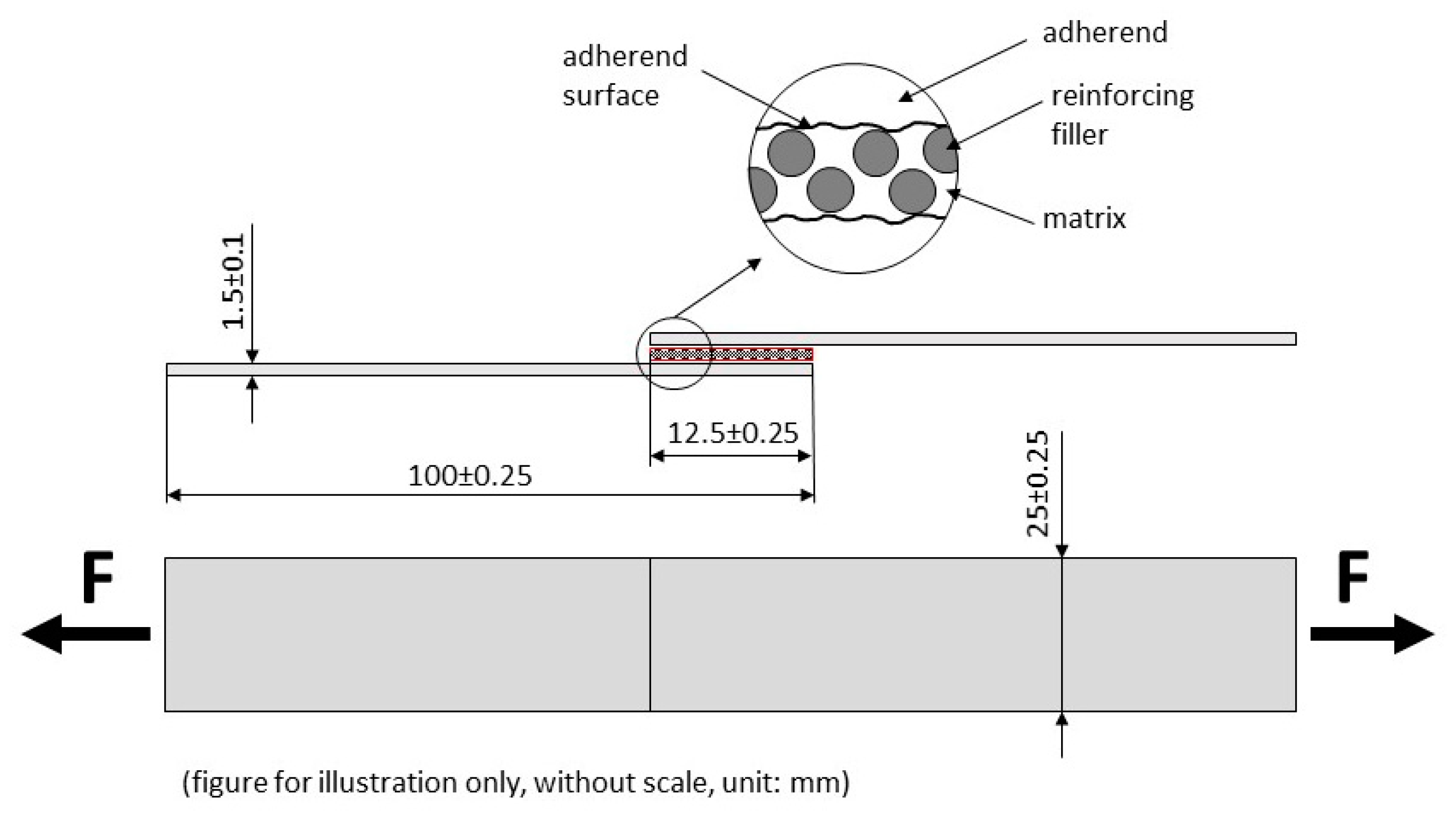
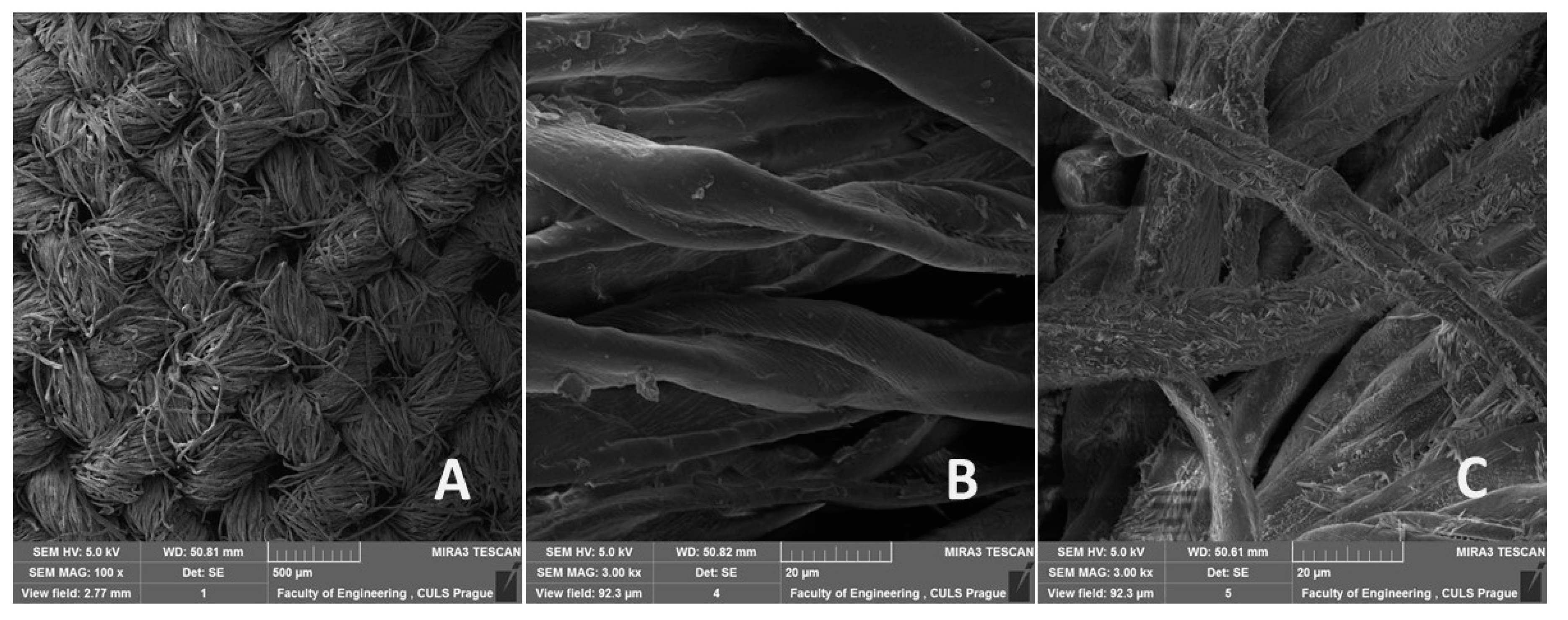



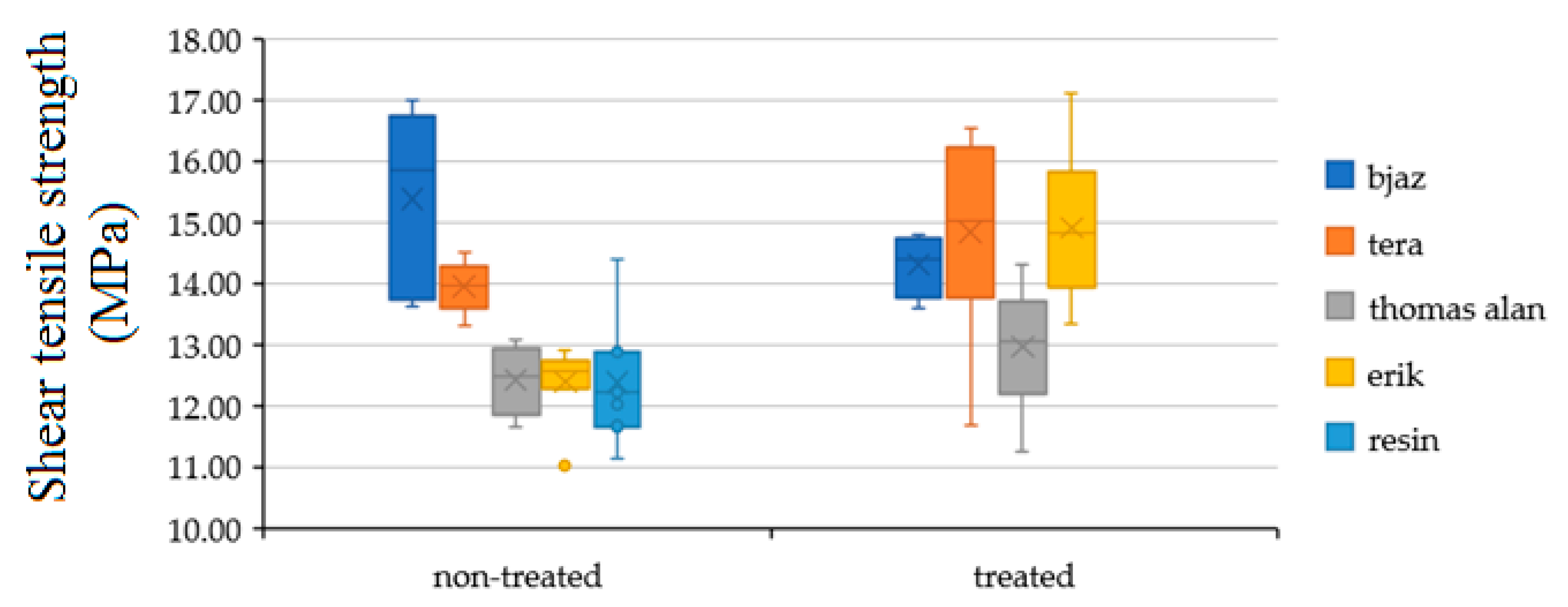
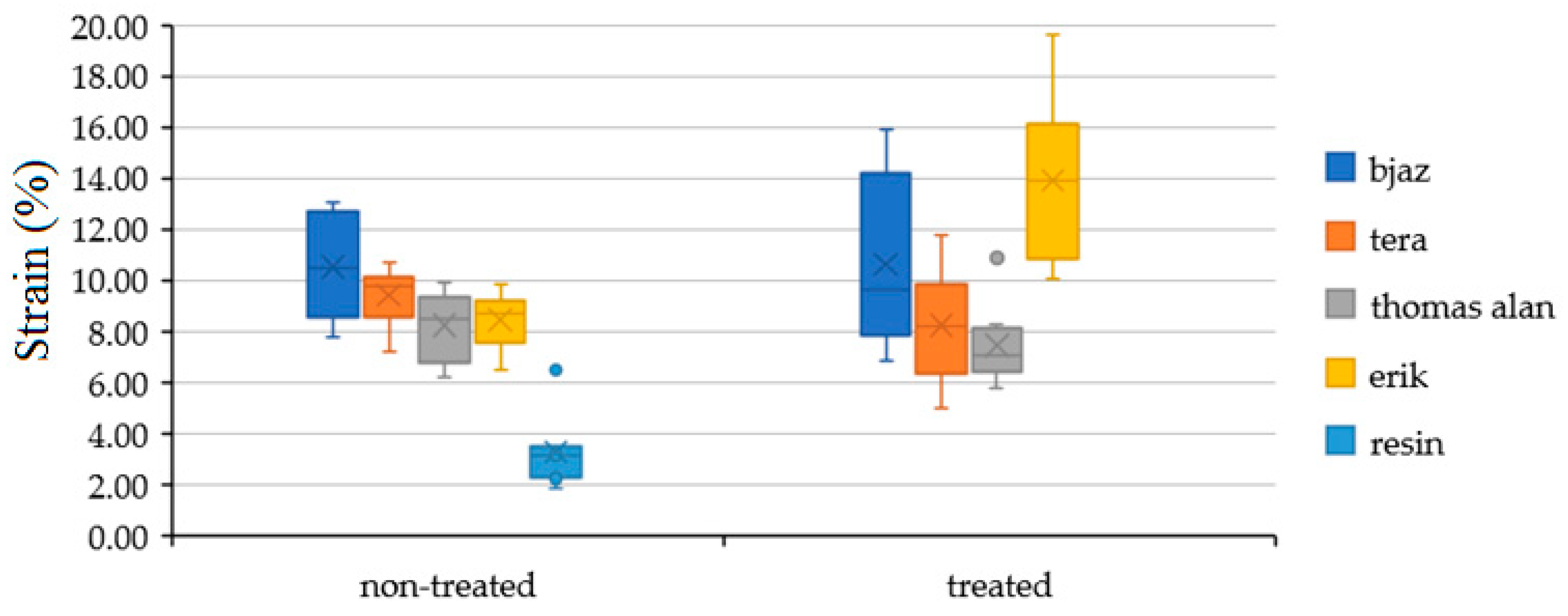


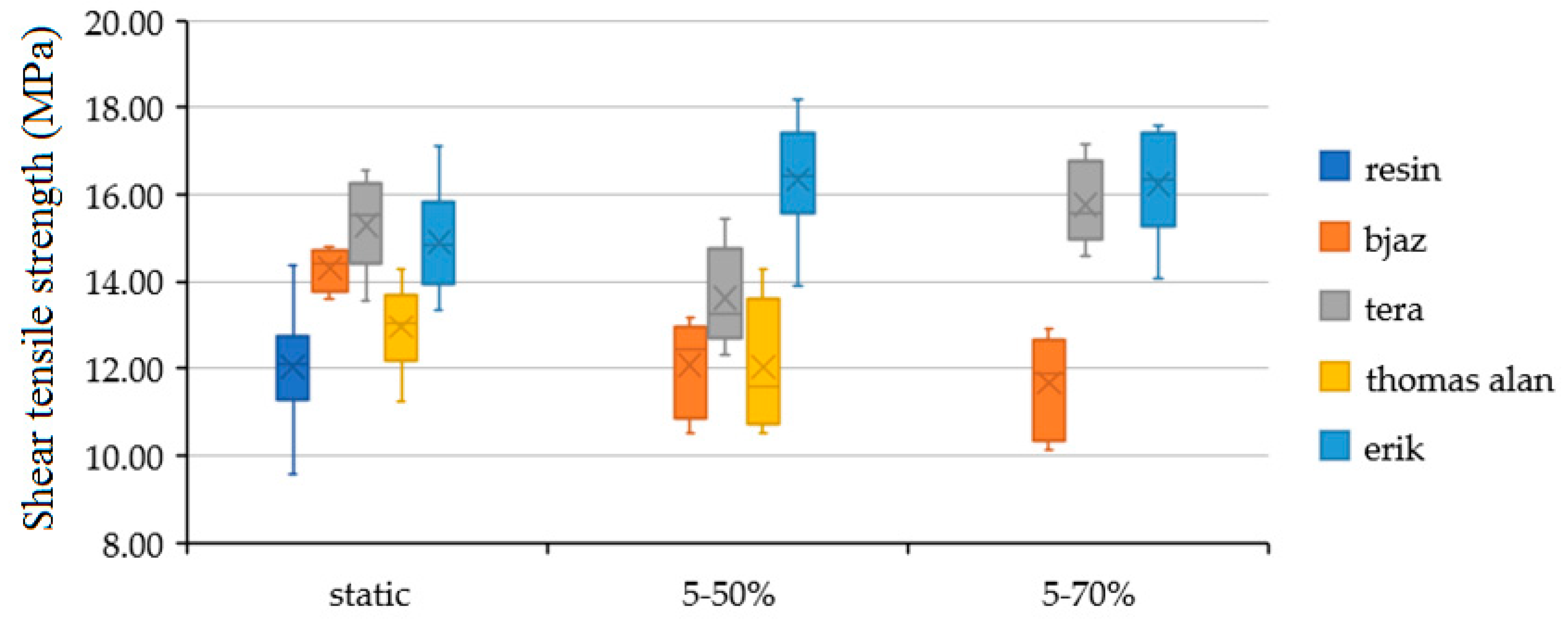

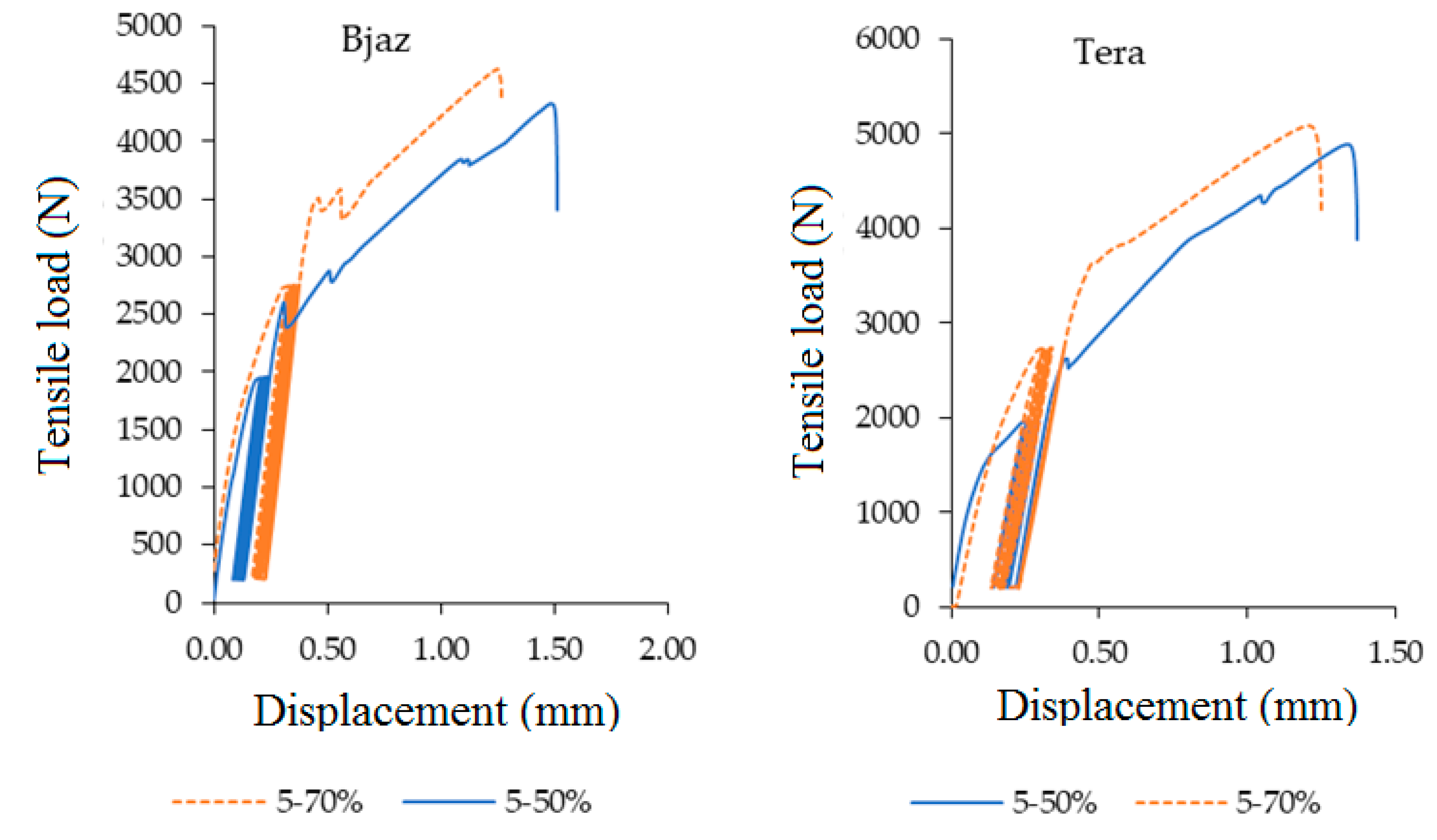

| Fabric | Geometry | Areal Density | Warp Way Strength (200 × 50 mm2) | Weft Way Strength (200 × 50 mm2) | Composite Layer Thickness |
|---|---|---|---|---|---|
| g·m−2 | N | N | µm | ||
| BJAZ | Plain | 145 | 400 | 400 | 530 ± 14 |
| TERA | Plain | 305 | 950 | 900 | 312 ± 14 |
| THOMAS ALAN | Twill | 230 | 850 | 500 | 342 ± 6 |
| ERIK | Plain | 190 | 850 | 800 | 312 ± 14 |
| Static Load Test | p-Value | ||||||
|---|---|---|---|---|---|---|---|
| Hybrid Adhesive Bonds | Shear Tensile Strength | Strain | Shear Tensile Strength | Strain | |||
| MPa | % | ||||||
| RESIN | 12.02 | ±1.29 | 3.56 | ±1.54 | - | - | |
| BJAZ | treated | 14.30 | ±0.45 | 10.62 | ±3.16 | 0.03 | 0.00 |
| TERA | 15.28 | ±1.05 | 8.66 | ±1.77 | 0.00 | 0.00 | |
| THOMAS ALAN | 12.95 | ±0.92 | 7.44 | ±1.48 | 0.03 | 0.00 | |
| ERIK | 14.90 | ±1.15 | 13.89 | ±3.11 | 0.00 | 0.00 | |
| BJAZ | non-treated | 15.38 | ±1.34 | 10.50 | ±1.98 | 0.02 | 0.09 |
| TERA | 13.94 | ±0.38 | 9.41 | ±1.09 | 0.16 | 0.19 | |
| THOMAS ALAN | 12.42 | ±0.55 | 8.23 | ±1.29 | 0.21 | 0.30 | |
| ERIK | 12.39 | ±0.55 | 8.43 | ±1.04 | 0.00 | 0.00 | |
| Adhesive Bond Type | Shear Tensile Strength | Strain | ∆Strain (1–1000 cyc.) | Finish Tests | Shear Tensile Strength | Strain | ||||
|---|---|---|---|---|---|---|---|---|---|---|
| (MPa) | (%) | (%) | (-) | (p-Value) | ||||||
| Quasi-static 5–50% | RESIN | 0 | 0 | 0 | 5/8 | - | - | |||
| BJAZ | 12.08 | ±1.00 | 8.67 | ±2.41 | 0.37 | ±0.20 | 8/8 | 0.00 | 0.11 | |
| TERA | 13.61 | ±1.08 | 7.83 | ±1.71 | 0.24 | ±0.18 | 8/8 | 0.01 | 0.41 | |
| THOMAS ALAN | 12.02 | ±1.37 | 7.78 | ±1.61 | 0.19 | ±0.05 | 8/8 | 0.18 | 0.71 | |
| ERIK | 16.34 | ±1.24 | 10.79 | ±1.98 | 0.28 | ±0.16 | 8/8 | 0.04 | 0.04 | |
| Quasi-static 5–70% | RESIN | 0 | 0 | 0 | 4/8 | - | - | |||
| BJAZ | 11.67 | ±1.01 | 7.81 | ±1.08 | 0.43 | ±0.09 | 8/8 | 0.00 | 0.02 | |
| TERA | 15.75 | ±0.85 | 9.94 | ±1.90 | 0.35 | ±0.18 | 8/8 | 0.41 | 0.25 | |
| THOMAS ALAN | 0.00 | ±0.00 | 0.00 | ±0.00 | 0.00 | ±0.00 | 4/8 | 0.00 | 0.00 | |
| ERIK | 16.22 | ±1.14 | 10.63 | ±1.92 | 0.36 | ±0.18 | 8/8 | 0.06 | 0.04 | |
Publisher’s Note: MDPI stays neutral with regard to jurisdictional claims in published maps and institutional affiliations. |
© 2020 by the authors. Licensee MDPI, Basel, Switzerland. This article is an open access article distributed under the terms and conditions of the Creative Commons Attribution (CC BY) license (http://creativecommons.org/licenses/by/4.0/).
Share and Cite
Tichý, M.; Kolář, V.; Müller, M.; Mishra, R.K.; Šleger, V.; Hromasová, M. Quasi-Static Shear Test of Hybrid Adhesive Bonds Based on Treated Cotton-Epoxy Resin Layer. Polymers 2020, 12, 2945. https://doi.org/10.3390/polym12122945
Tichý M, Kolář V, Müller M, Mishra RK, Šleger V, Hromasová M. Quasi-Static Shear Test of Hybrid Adhesive Bonds Based on Treated Cotton-Epoxy Resin Layer. Polymers. 2020; 12(12):2945. https://doi.org/10.3390/polym12122945
Chicago/Turabian StyleTichý, Martin, Viktor Kolář, Miroslav Müller, Rajesh Kumar Mishra, Vladimír Šleger, and Monika Hromasová. 2020. "Quasi-Static Shear Test of Hybrid Adhesive Bonds Based on Treated Cotton-Epoxy Resin Layer" Polymers 12, no. 12: 2945. https://doi.org/10.3390/polym12122945
APA StyleTichý, M., Kolář, V., Müller, M., Mishra, R. K., Šleger, V., & Hromasová, M. (2020). Quasi-Static Shear Test of Hybrid Adhesive Bonds Based on Treated Cotton-Epoxy Resin Layer. Polymers, 12(12), 2945. https://doi.org/10.3390/polym12122945







